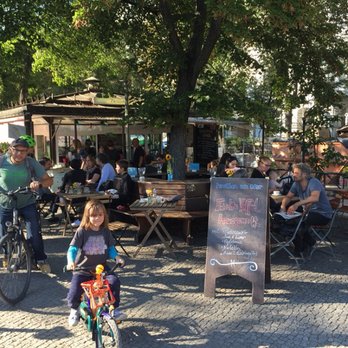
Amid overtourism struggles, a fresh drive spotlights lesser-explored city outskirts, offering funky culture, historical treasures, and wild greenery.
A cable car in Berlin?” The man grilling my burger at Piri’s, a self-proclaimed dive bar diner in Neukölln, an inner-city neighborhood to the southeast, seems doubtful. “Yeah,” confirms his colleague from New Zealand. “My parents tried it. There’s some sort of garden.”
Both cooks have resided here for over a decade. They playfully label Neukölln as “the ghetto,” apparently unaware of the nearby 18th-century castle, Schloss Britz, and the expansive 220-acre Britzer Garten – not to mention the cable car in the northeastern Marzahn district, a 45-minute train ride away.
A fresh effort called “Ab ins B!” (Let’s Go to the B!) led by Jana Friedrich, the head of the tourism board for Spandau – a district in the western part of the city, aims to address this lack of awareness. While Berlin’s A-zone, encompassed by the S-Bahn’s Ring and home to iconic attractions like the Brandenburg Gate, Reichstag, Museum Island, Checkpoint Charlie, and the Holocaust Memorial, grapples with issues of overtourism, it represents merely three out of the city’s twelve districts. Beyond that, in the B-zone (comparable to London’s zone 2), lie nine other districts, including Treptow-Köpenick, Tempelhof-Schöneberg, Steglitz-Zehlendorf, Marzahn-Hellersdorf, and, of course, Spandau – all ready to be explored.
The concept behind ‘Ab ins B!’ aimed to spotlight the attractions beyond the city center,” Friedrich explains. “We initially tested this idea locally, and its success has led us to explore methods of raising awareness about these less-explored areas for international tourists. Presently, the Ab ins B! segment on the Visit Berlin website (also available in English) provides comprehensive insights into each B-zone neighborhood and their offerings.”
An essential tool for planning your journey into Berlin’s outskirts is the metro map, encompassing both the S and U-Bahn lines. I acquire one of these, along with a Berlin Welcome Card (accessible online or at tourist information centers). Not only does the card permit unrestricted travel in zones A and B, but its accompanying guidebook also presents unique suggestions and provides discounts for select attractions, including Berlin’s sole indoor surfing arena located in the B-zone’s Lichtenberg district.
I’ve never viewed Berlin as lush and meticulously maintained. I’ve consistently perceived the city as bearing the marks of its divided history, whether willingly or not. This, to me, is fundamental to its rightful standing as a dynamic cultural hub where exuberance and creativity flourish against a somber past.

For history enthusiasts, there’s a wealth of exploration awaiting in the B-zone. A trip of about 40 minutes from Alexanderplatz takes me to Wannsee, where I tour the Haus der Wannsee-Konferenz. This site saw SS and Nazi party representatives gather in 1942 to discuss the infamous “final solution” concerning the Jewish population. In Schöneberg’s Bayerischer Platz, a mere 12-minute train ride from Hermannplatz, an arrangement of 80 placards in German starkly presents the legislation that systematically isolated the Jewish community in the prelude to the Holocaust. In Treptow-Köpenick to the southeast, I visit the Nazi Forced Labour Documentation Centre, established within a former camp where prominent images of “workers” are accompanied by fragments of letters and journal entries.
Beyond Museum Island in central Berlin, I uncover an abundance of cultural treasures. Notably, I explore Liebermann Villa, the charming former summer residence of the painter Max Liebermann. Just a five-minute stroll along the lakeside from Haus der Wannsee-Konferenz, this villa hosts a permanent exhibition showcasing the artist’s creations, many of which draw inspiration from the splendid surrounding gardens. Venturing to the western Spandau district, I pay a visit to the Georg Kolbe Museum. Here, the sculptor’s masterpieces are presented alongside a dynamic rotation of classical modernism works. In Lichtenberg, situated immediately east of the Ring, I immerse myself in the captivating world of Dark Matter. This collection of light and sound installations is situated within the bewildering darkness of a former factory, creating a truly immersive experience.
Setting out daily from my Spree-side hotel, Abion, in Bellevue, I come to the realization that the B-zone is just as captivating as the city center, with the added charm of abundant green spaces. After departing from the somber atmosphere of the Forced Labour Documentation Centre, I take a stroll under the spring sunshine to Wuhlheide Park. This park sprawls so expansively that it encompasses a miniature version of Berlin in the Modellpark. Beyond this, running and cycling trails meander through 500 acres of wild green landscapes. Embracing its status as Berlin’s greenest and most water-rich district, Treptow-Köpenick boasts an array of inviting riverside bars. At Mutter Lustig, situated by Köpenick Palace, I indulge in a gin-based cocktail while kayakers glide by in the river’s gentle currents.
Nestled within the outermost reaches of the Spandau district, Fort Hahneberg, Prussia’s ultimate artillery stronghold, is so discreetly integrated into the hillside that its proportions (initially constructed from 28 million bricks, many of which were repurposed in the postwar reconstruction of Berlin) appear almost implausible. A guide leads me beneath a Nazi eagle, its swastika defaced, into a serene and meticulously arranged interior. Here, the hallways are marked by doors to gunpowder storage rooms, and the silence is occasionally disrupted by the sounds of young raccoons. The external arches, now enveloped in lush vegetation, were the backdrop for the memorable baseball bat scene in Quentin Tarantino’s “Inglourious Basterds.”



